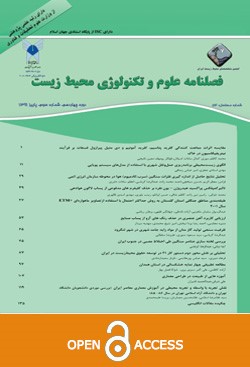Investigation on the concentration of heavy metals, lead and cadmium, and zinc concentration in the wheat produced in Iran
Subject Areas : Heavy metal
kobra sadat hasheminasab zavareh
1
*
![]() ,
karim shahbazi
2
,
kambiz bazargan
3
,
karim shahbazi
2
,
kambiz bazargan
3
1 - Assistant Professor, Soil and Water Research Institute, Agricultural Research, Education and Extension Organization (AREEO), Karaj, Iran. *(Corresponding Author)
2 - Associate Professor, Soil and Water Research Institute, Agricultural Research, Education and Extension Organization (AREEO), Karaj, Iran.
3 - Associate Professor, Soil and Water Research Institute, Agricultural Research, Education and Extension Organization (AREEO), Karaj, Iran.
Keywords: Zinc, Lead, Iran, Heavy Metals, Cadmium, wheat,
Abstract :
Background & Objective: We investigated the produced wheat of Iran in terms of heavy metal cadmium and lead, and also to measure the extent of zinc. Material and Methodology: The amount of the mentioned metals in 419 wheat samples, after preparation and extraction, was analyzed by atomic absorption spectrometry. Findings: The amount of cadmium in the 8.59 percent of wheat was higher than permissible limit in national standard index of Iran (0.03 mg/kg). In all provinces, the average amount of cadmium was less that the permissible limit, except Gilan. The findings showed that the amount of lead in 0.72 percent of analyzed samples was higher than permissible limit in the national index (0.15 mg/kg). In all provinces, the average amount of lead was less than national index of Iran. Analysis of concentration of zinc, a useful element, showed that in much of samples (about 79 percent), the concentration of this element less than acceptable level (30 mg/kg). Discussion and conclusion: The analysis of frequency distribution of heavy metals in different provinces of Iran showed that in Gilan province, the concentration of cadmium is more than permissible limit. Since that the permissible concentration of cadmium in the national standard of Iran is unreasonably exigent. It is suggested that the maximum tolerance limit for cadmium in wheat grain should be reviewed. If the Codex standard is considered as an indicator of the pollution of heavy wheat production in Iran, in relation to cadmium, none of the analyzed samples cadmium concentration has not exceeded the Codex limit. In addition, the results of zinc measurement in wheat samples indicate zinc deficiency in most of the samples. Therefore, regarding the share of bread in the food basket of Iranian society, increasing the concentration of zinc in the wheat of Iran should be taken into consideration.
_||_

